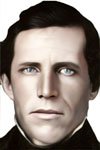Charles Anthon
|
1799 Rosetta Stone discovered. |
1828 Marin Harris claims that Prof. Charles Anthon certified the accuracy of Joseph Smith’s translation of Egyptian characters. Prof. Anthon denies. |
1830 Book of Mormon published. |
1858 English translation of Rosetta Stone completed. |
In February 1828, Joseph Smith claimed he copied characters from the Book of Mormon’s gold plates and gave them to Martin Harris, so he could have them inspected by Professor Charles Anthon, a respected classical scholar at Columbia College in New York.

|
Sometime in this month of February, the aforementioned Mr. Martin Harris came to our place, got the characters which I had drawn off the plates, and started with them to the city of New York. |
|

|
— Joseph Smith
Mormonism founder
|
- Martin and Professor Anthon gave different version of events.
| Martin Harris | Charles Anthon | ||
|---|---|---|---|
 |
 |
||
|
I went to the city of New York, and presented the characters which had been translated, with the translation thereof, to Professor Charles Anthon, a gentleman celebrated for his literary attainments. Professor Anthon stated that the translation was correct, more so than any he had before seen translated from the Egyptian.
|
The whole story about my having pronounced the Mormonite inscription to be "reformed Egyptian hieroglyphics" is perfectly false.
|
||

|
— Martin Harris
Book of Mormon witness
|

|
— Charles Anthon
Columbia University
|
- Martin lost his farm and wife as a result of financing the first printing of the Book of Mormon.
- In determining who is telling the truth, we know that:
- Translating Egyptian hieroglyphics was not possible until the discovery and deciphering of the Rosetta Stone. The English translation of the stone was completed in 1858. Therefore, it would have been premature for Charles Anthon to certify that Joseph Smith’s translation was correct, as Martin Harris claims.
- Moreover, the Book of Mormon narrative says that its language is Reformed Egyptian, which remains an unknown language today.
- The Prophet, an LDS newspaper, published the characters that were shown to Professor Charles Anthon. These characters are clearly not Egyptian.

1844 broadside in the LDS newspaper The Prophet promoting the Book of Mormon characters shown to Professor Charles Anthon. The newspapers’ editors include Mormon apostles William Smith and Parley P. Pratt.
Conclusion
Martin Harris, who financed the first printing of the Book of Mormon, had a personal interest in its success. Meanwhile, Joseph Smith needed to establish that his book was a genuine ancient record to support his claim of being divinely chosen—to translate and ultimately restore Christianity. The fact that Joseph’s church promoted the story of Professor Anthon’s alleged endorsement exposes how unscrupulous the founders of the LDS church were.






